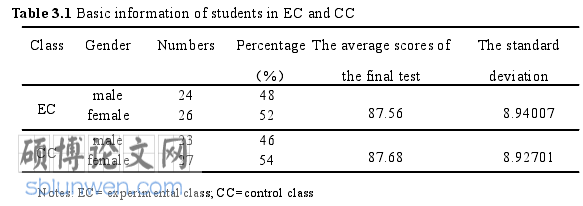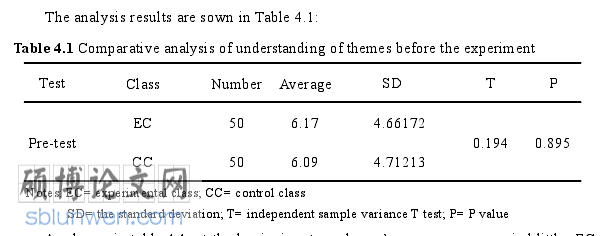Chapter One Introduction
1.1The research background
Reading, as one of the main component parts of English learning, occupies animportant position in English teaching. As a method of language input, it can lead toefficient language output. Therefore, English reading ability is not only one of the mostimportant language abilities, but also the basis and prerequisite for the development ofother language abilities. In order to have the best English learning effect, teachers must payspecial attention to improving students’ reading ability.
There are many effective ways to develop students’ reading ability, among which isEnglish literature reading. Many reasons account for this. For instance, English literaturereading enables students to guess word meaning according to the plots so as to increasetheir reading speed and enlarge their vocabulary; it enables students to deepen theunderstanding of the text according to the thematic significance. Therefore, Ding (2013)proposed that reading teaching without literature will result in dull teaching content andlow teaching efficiency. English Curriculum Standards for Senior High School (TheMinistry of Education of the People’s Republic of China, 2018) (ECS) also sets specificrequirements for students’ reading ability: “level eight requires students to be able toappreciate simple literary works with the help of the teacher” while “level nine requiresstudents to be able to read the general English original works, grasp the main plots andunderstand the main characters”, which highlights the important role of literature readingin developing students' reading ability.
However, teachers used to regard language knowledge teaching as the reading class’sfocus. And the traditional bottom-up teaching method makes the teacher pay too muchattention to drilling language points thus relatively neglect the cultivation of students’literary appreciation ability, which leads to students’ poor performance.
..........................
1.2The purpose and significance of the study
This study aims to explore the effects of discourse-analysis based literature readingteaching on high school students’ literary appreciation ability. Firstly, the author introducesdiscourse analysis theory, which is of great value during the whole process. Secondly, theauthor applies discourse analysis to literature reading teaching to construct a new teachingmodel in class, which requires the teacher to pay special attention to cultivating students’awareness of discourse. Last but not least, the author makes a conclusion based on theexperiment and some implications are proposed due to the experiment’s findings.
The English syllabus in senior high school pays attention to developing and trainingstudents’ ability of reading, especially the cultivation of literary appreciation ability.However, the weak point of the traditional reading teaching mode is that it focuses toomuch on the teaching of vocabulary and grammar, relatively ignoring the importance ofdiscourse. Fortunately, the application of the discourse analysis method in Englishliterature reading teaching can solve the problem. Therefore, the significance of the studycan be divided as follows:
From the perspective of theory, previous studies mainly focused on college readingclasses that applied discourse analysis to English literature reading teaching. But, fewresearches were conducted in senior high schools’ English reading classes. Therefore, thisresearch will conduct an experiment in high school English classes to fill in such gap.
From the viewpoint of practice, this thesis tries to establish a new teaching model.Firstly, the author provides English teachers with discourse-analysis based literaturereading. Teachers are required to pay more attention to discourse analysis rather than theanalysis of words or grammatical rules. Secondly, students will not receive knowledgepassively any longer. They will be taught various reading skills to cultivate the awarenessof discourse, which is beneficial to improving their literary appreciation ability.
...........................
Chapter Two Literature Review
2.1Discourse analysis
This part could be further divided into four sections: the definition of discourseanalysis, its theoretical basis, methods as well as its empirical studies at home and abroad.
2.1.1 The definition and theoretical basis of discourse analysis
2.1.1.1 The definition of discourse and discourse analysis
As a relatively broad concept, discourse can be used to denote any relativelycomplete linguistic materials, with no limit of form or text. Therefore, “discourse” and“text” are both reasonable titles for it. Single words, phrases and even poetry, dialogue,prose and so on can also be called discourse. Under different historical background,scholars have different understandings of discourse. As for the original concept, it wasproposed by Harris, “Language does not exist in scattered words or sentences, but inconnected discourse” (Harris, 1952: 28). The implication is that we can analyze discoursefrom two sides: describe language beyond the boundaries of sentences or study therelationship between language and culture. According to the applied linguistics, discourseis the use of several combined sentences (Widdowson, 1979). In other words: one is“combined sentences”; the other is “the usage of sentences”. But for Halliday and Hason(1976), discourse is a semantic unit. That’s to say, discourse is not a unit of form, but a unitof meaning. Some scholar regards discourse as “a structure system that expresses multiplemeanings and has internal logical relevance.” (Xu, 1990: 11). Others refer it as ameaningful linguistic unit and a communicative event that can convey completeinformation and are logically coherent and linguistically cohesive, and have a certaincommunicative purpose and function (Liu, 1999). Furthermore, Leech (1966) with threeBritish linguists gave a more explicit definition, pointing out that discourse is applicable toboth spoken and written language. In fact, it can be said that discourse is actuallyapplicable whole. Thus, we may conclude that a discourse, with cohesion and coherence among its components, consists of more than one paragraph or sentence.
..............................
2.2Literature reading
As one of language input methods, reading occupies a prominent position among thefour skills of listening, speaking, reading and writing. This part focuses on the teaching ofEnglish literature reading. Understanding relevant reading theories, its basic meaning andreading processes is the premise of discourse-analysis based literature reading teaching.
2.2.1 The definition of literature reading
Reading is one kind of language activities as well as a kind of thinking activities. It isa complex process of transforming linguistic symbols into meaning understanding throughpsychological cognition. As a language activity, it is the process of extracting informationfrom text. As a psychological process, it is the process of processing the input of externalvisual signals (Wang, 2008). In the process of reading, the reader decodes the informationof the visual input language symbols to obtain the information originally intended by theauthor. In other words, the author encodes meaning into written language, and the readerencodes written language into meaning. The reading process of readers is not a passiveprocess of absorbing information, but a dynamic and positive thinking process (Huang &Huang, 2012). It is a process of interaction and reaction between old and new informationin the human brain. It is reader and author’s mutual communication process. Therefore, inreading teaching, teachers should not only emphasize the analysis of words, but alsoemphasize the analysis of discourse (ECS, 2018).

文学鉴赏论文怎么写
Literature is defined as: “Pieces of writing that are valued as works of art, especiallynovels, plays and poems, in contrast to technical books, e.g., newspapers and magazines,etc.” (Hornby, 1988: 356). This definition emphasizes that literature includes novel, drama,etc., and is the corresponding form of science and technology books, newspapers,magazines and so on. The famous literary theorist Tong and Ma (2005: 104-105) once putforward two ways to define it: “In the broad sense, it regards literature as culture; In thenarrow sense, literature refers to the current literature, that is, language artistic behaviorsand works that contain comprehensive factors, e.g., poems, novels and essays.” Accordingto the above definition, the literary reading in this study refers to literature in the narrowsense, and mainly refers to the study of English novel reading.
............................
Chapter Three Research Methodology..................................25
3.1 Research questions.............................................. 25
3.2 Research subjects........................................... 25
3.3 Research instruments.......................................26
Chapter Four Results and Discussion................................47
4.1 Effects of discourse-analysis based literature reading teaching on students’understanding of themes..............................47
4.1.1 Students’ understanding of themes before the experiment between twoclasses.....................47
4.1.2 Students’ understanding of themes after the experiment between twoclasses.............................48
Chapter Five Conclusion...................... 62
5.1 Major findings...........................62
5.2 Limitations.......................................63
5.3 Implications and suggestions.....................64
Chapter Four Results and Discussion
4.1Effects of discourse-analysis based literature reading teaching onstudents’ understanding of themes
Students’ understanding of literary works’ themes mainly reflects in such process:combined with background knowledge (content schema), readers can grasp the discoursewholly while sort out the paragraph or key words (recurring segments, words withimplications, etc.) to generalize the theme.
This part divides into three sections, in which the related test scores, questionnaireand interview results will be discussed in details.
4.1.1 Students’ understanding of themes before the experiment betweentwo classes
Especially, Q 65, 69, 74 in the pre-test are all about the perception of theimplications beyond the words, which are used to test students’ understanding of literarywork’s themes.

文学鉴赏论文参考
Chapter Five Conclusion
5.1Major findings
Through three months’ experiment, the author finds that compared with the traditionalfive-step teaching mode centered on word meaning and grammar in CC, the teaching modeof discourse-analysis based literature reading teaching in EC can better improve students’literary appreciation ability.
The results are summarized as follows:
Firstly, it can improve students’ understanding of themes, which embodies in theselective perception of the information beyond the text, e.g., recurring segments, wordswith implications, etc. During the process, by activating content schema, studentseffectively improve their ability to interpret the plots of literary texts. But due to thelimited research time (only lasted three months) and students’ current literature readingproficiency, the effect on their diverse and deep comprehension of literature’s themes is notsignificant. Especially for the middle-and-low level students, although their comprehensiveunderstanding of themes has been greatly improved, they still have difficulties in deeplyunderstanding the themes.
Secondly, it can improve students’ understanding of characters. They used to evaluateprotagonists from the single dimension. However, after the experiment, most of them areaware of understanding characters from “what-how-why” three-dimensional aspects, thatis , (1) Consciously nterrelationships between the various characters, etc. What’s more, students feel closer towork’s protagonists due to their better understanding of them. However, taking middle-and-low level students’ performance into consideration, although their discourseawareness has been greatly improved, the better outcomes of the understanding ofcharacters still need long-time training.
Thirdly, it can improve students’ appreciation of language description and structure. Itis such a process that readers use their discourse awareness to find out the distinctivelanguage style, which involves many aspects, such as, the style color, word use, etc. What’smore, students are able to use discourse analysis to evaluate the delicate structure ofliterary works. Especially, the high level students build up strong confidence in the analysisof literature work’s language description and structure. It’s also worth mentioning that lowlevel students are even more willing to apply discourse analysis to appreciate literaturediscourse pattern than middle level students. In short, all of them become more sensitive tothe sentence pattern and the words that are used to build up the plot development andcharacters’ traits. Thus, it’s easier for them to appreciate the language description andstructure.
reference(omitted)
